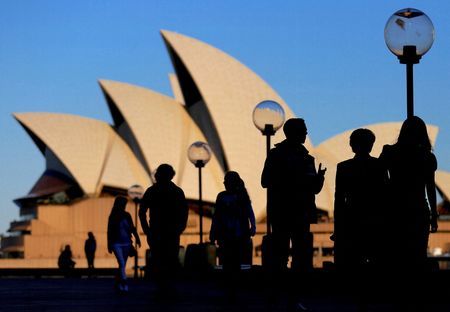By Tom Westbrook
SINGAPORE (Reuters) – Australia’s stockmarket is pulling in a growing slice of global investors’ funds, as the prospect of big dividends, relatively defensive performance and exposure to China’s reopening attracts cash despite a looming domestic slowdown.
Australia’s A$2.3 trillion ($1.6 trillion) bank-and-miner dominated S&P/ASX 200 index has the highest dividend-to-stockprice ratio among major markets and has outperformed nearly all its developed-market peers this year.
Flows suggest that investors are betting on the run extending and that their views on what has been regarded as a rather boring, low-growth Asia-Pacfic corner are shifting as the allure of its healthcare, energy and resources sectors brightens.
Before the pandemic, many investors had been happy to talk about Australia as a good defensive market that offered strong commodities exposure, said Morgan Stanley equity strategist, Chris Nicol. “But they were generally underweight Australia, because there was so much growth in the region,”
“I’d say the interest in Australia is as strong as I’ve seen in the last 12 years, via offshore flows,” he added, especially as cash has flowed from China. “Pre-COVID, a lot of that money would come in and out. Today we can see it’s firmly entrenched.”
Morgan Stanley reckons the ASX 200 can gain about 7% in 2023 and prefers energy, healthcare and diversified miners over banks and other companies exposed to consumption or housing.
This year is set to be the third in a row to show net foreign inflows into Australia, with more than $5.2 billion entering in the 10 months to October, according to Lipper equity fund flows figures.
Separate data from analytics firm EPFR shows allocation to Australia within global ex-U.S. funds is rising and has hit a near six-year high of almost 15% for Asia-Pacific funds – roughly approaching market weight.
Australia’s weighting in the widely tracked MSCI Asia ex-Japan index is 17% this year, up from about 16% at the end of 2019.
CHINA PAYOFF
Hints that the central bank is almost finished with raising interest rates are driving optimism. So are relaxation in China’s COVID-19 policy and an apparent thaw in what were frosty Australia-China relations.
“This will be a longer-term story but the immediate impact from China’s reopening is very significant,” since it would generate demand for Australia’s mining output, said Sat Duhra, who runs an income-focused Asia-Pacifc portfolio at Janus Henderson in Singapore.
Australia “is our biggest country weight by some distance …. At the margin, I wouldn’t be uncomfortable adding a little bit more,” he said.
The country’s tax rules treat dividends favourably, so companies pay a lot of them. Furthermore, big miners have been prudent with their excellent profits of the past few years, refraining from heavy capital expenditure and acquisitions; instead, cash has gone back to shareholders.
Across the market, the ratio of annual dividends to share prices is 6.4%, far higher than 2.1% for the S&P 500 or 3.9% for Britain’s FTSE 100.
Shares in Australia’s most valuable company, BHP Group, are up by a quarter this year; the annual gain is set to be the best since 2016. While the ASX 200 is down 3.5% so far this year, world stocks have lost 18%.
Education is another sector that analysts see benefiting from warming ties with China, through a resumption of student enrolments. Both UBS and Morgan Stanley recommend student placement and English-qualification firm IDP Education as Australian student-visa issuances turn upward.
IDP has no earnings forecasts but has reported a pick-up in applications and leads and said in an emailed statement to Reuters that it expected Chinese students would still want to take in-person courses abroad as restrictions began to ease.
Risk, analysts say, is primarily focused on Australia’s housing market and consumption as interest rates rise. Local fund managers’ holdings of Australia’s big banks, which have heavy exposure to housing loans, are accordingly hovering near record lows.
Still, Goldman says better margins are enough to offset concerns over stress or credit growth for banks, while UBS and Morgan Stanley expect a relatively mild economic slowdown.
Moveover, UBS points out that Australian stocks have dropped in two consecutive years only three times since 1973.
($1 = 1.4874 Australian dollars)
(Reporting by Tom Westbrook; Additional reporting by Gaurav Dogra in Bengaluru; Editing by Bradley Perrett)

